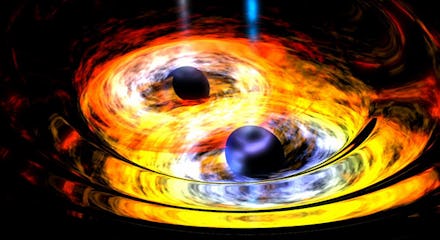Gravitational Waves May Have Come From a Black Hole Pair Born in a "Mosh Pit"

Back in February, astronomers detected the world's first signal of gravitational waves — ripples through the fabric of space-time that come from powerful events like exploding stars. In the case of the signal detected in February, the gravitational waves came from a pair of black holes that spiraled closer and closer together until they merged.
But how did those black holes end up so close together in the first place? New research published in the Astrophysical Journal Letters might have an answer.
Dense pockets of stars called globular clusters are basically black hole factories. Stars inside them will regularly collapse into black holes. The really big black holes get sucked into the middle of the cluster, and they swirl around like ingredients in a blender.
Pairs of black holes will sometimes get ejected during the shuffle.
"Once those kick each other out, either as single or binary black holes, the next-most massive black holes rush in and start a new mosh pit," astronomer Carl Rodriguez told New Scientist.
The ones that get ejected as pairs might be close enough to merge and produce gravitational waves.
When Rodriguez and his team simulated how black holes behave inside globular clusters, they found that of the 262 black hole pairs that came out of their simulation, 14 of those were about the same mass as the two black holes that produced the gravitational waves in February.
The research doesn't prove that the binary black holes that created the first gravitational wave signal were created this way. They could have also formed from a separate pair of stars that collapsed into black holes outside the cluster. If the stars were originally close enough together, they could have formed a binary black hole that would eventually merge.
Astronomers will be able to study the source of gravitational waves once we've detected more of them. The Laser Interferometer Gravitational Wave Observatory is searching for more signals.